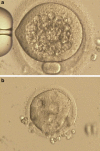Embryo developmental capability and pregnancy outcome are related to the mitochondrial DNA copy number and ooplasmic volume
- PMID: 23897005
- PMCID: PMC3824848
- DOI: 10.1007/s10815-013-0062-6
Embryo developmental capability and pregnancy outcome are related to the mitochondrial DNA copy number and ooplasmic volume
Abstract
Purpose: To investigate the correlation between the ooplasmic volume and the number of mitochondrial DNA (mtDNA) copies in embryos and how they may affect fecundity.
Method: Using real-time PCR, mtDNA quantification was analyzed in unfertilized oocytes and uncleaved embryos. The size of the ovum was also assessed by calculating the ooplasmic volume at the time of granulosa cell removal for IVF or ICSI. Quantification analysis of the mtDNA in blastomeres was performed by real-time PCR at the 7-8 cell stage of the cleaved embryos at 72 h after oocyte retrieval. We calculated the cytoplasmic volume of the blastomeres.
Result: Our studies showed a significantly lower mtDNA copy number in unfertilized oocytes and uncleaved embryos in women who were older than 40 years of age (p < 0.05). The larger ooplasmic volume was also associated with earlier and more rapid cleavage (p < 0.05). The ooplasmic volume was also significantly larger in the group achieving pregnancy. We found a significant positive correlation between blastomere volume and the number of mtDNA copies (r = 0.76, p < 0.01, from Pearson product-moment correlation coefficient).
Conclusions: We have shown that blastomere volume is directly proportional to the number of mtDNA copies. Therefore, larger cytoplasmic volume, with earlier cleavage speed, implies more mtDNA copies. Evaluation of mtDNA quantification and the measurement of ooplasmic and blastomere volume may be useful for selection of high quality embryo and pregnancy outcome.
Figures







Similar articles
-
Mitochondria directly influence fertilisation outcome in the pig.Reproduction. 2006 Feb;131(2):233-45. doi: 10.1530/rep.1.00551. Reproduction. 2006. PMID: 16452717
-
A systematic analysis of the suitability of preimplantation genetic diagnosis for mitochondrial diseases in a heteroplasmic mitochondrial mouse model.Hum Reprod. 2014 Apr;29(4):852-9. doi: 10.1093/humrep/deu016. Epub 2014 Feb 12. Hum Reprod. 2014. PMID: 24524987
-
The mitochondrial DNA copy number of cumulus granulosa cells may be related to the maturity of oocyte cytoplasm.Hum Reprod. 2020 May 1;35(5):1120-1129. doi: 10.1093/humrep/deaa085. Hum Reprod. 2020. PMID: 32358599
-
Spontaneous and artificial changes in human ooplasmic mitochondria.Hum Reprod. 2000 Jul;15 Suppl 2:207-17. doi: 10.1093/humrep/15.suppl_2.207. Hum Reprod. 2000. PMID: 11041526 Review.
-
Mitochondrial DNA as a biomarker for in-vitro fertilization outcome.Curr Opin Obstet Gynecol. 2016 Jun;28(3):158-63. doi: 10.1097/GCO.0000000000000274. Curr Opin Obstet Gynecol. 2016. PMID: 27077472 Review.
Cited by
-
Reproductive aging is associated with changes in oocyte mitochondrial dynamics, function, and mtDNA quantity.Maturitas. 2016 Nov;93:121-130. doi: 10.1016/j.maturitas.2016.06.015. Epub 2016 Jun 23. Maturitas. 2016. PMID: 27523387 Free PMC article.
-
Transcriptome analysis of human cumulus cells reveals hypoxia as the main determinant of follicular senescence.Mol Hum Reprod. 2016 Aug;22(8):866-76. doi: 10.1093/molehr/gaw038. Epub 2016 Jun 6. Mol Hum Reprod. 2016. PMID: 27268410 Free PMC article.
-
Molecular basis of reproductive senescence: insights from model organisms.J Assist Reprod Genet. 2021 Jan;38(1):17-32. doi: 10.1007/s10815-020-01959-4. Epub 2020 Oct 1. J Assist Reprod Genet. 2021. PMID: 33006069 Free PMC article. Review.
-
Investigating developmental characteristics of biopsied blastocysts stratified by mitochondrial copy numbers using time-lapse monitoring.Reprod Biol Endocrinol. 2024 Jul 30;22(1):89. doi: 10.1186/s12958-024-01262-2. Reprod Biol Endocrinol. 2024. PMID: 39080754 Free PMC article.
-
Mitochondrial function of human embryo: Decline in their quality with maternal aging.Reprod Med Biol. 2022 Dec 21;21(1):e12491. doi: 10.1002/rmb2.12491. eCollection 2022 Jan-Dec. Reprod Med Biol. 2022. PMID: 36570768 Free PMC article. Review.
References
-
- Hill GA, Freeman M, Bastias MC, Rogers BJ, Herbert CM, 3rd, Osteen KG, Wentz AC. The influence of oocyte maturity and embryo quality on pregnancy rate in a program for in vitro fertilization–embryo transfer. Fertil Steril. 1989;52(5):801–806. - PubMed
-
- Shulman A, Ben Nun I, Ghetler Y, Kaneti H, Shilon M, Beyth Y. Relationship between embryo morphology and implantation rate after in vitro fertilization treatment in conception cycles. Fertil Steril. 1993;60(1):123–126. - PubMed
-
- Cohen J, Inge KL, Suzman M, Wiker SR, Wright G. Videocinematography of fresh and cryopreserved embryos: a retrospective analysis of embryonic morphology and implantation. Fertil Steril. 1989;51(5):820–827. - PubMed
-
- Pelinck MJ, De Vos M, Dekens M, Van der Elst J, De Sutter P, Dhont M. Embryos cultured in vitro with multinucleated blastomeres have poor implantation potential in human in vitro fertilization and intracytoplasmic sperm injection. Hum Reprod. 1998;13(4):960–963. doi: 10.1093/humrep/13.4.960. - DOI - PubMed
Publication types
MeSH terms
Substances
LinkOut - more resources
Full Text Sources
Other Literature Sources

